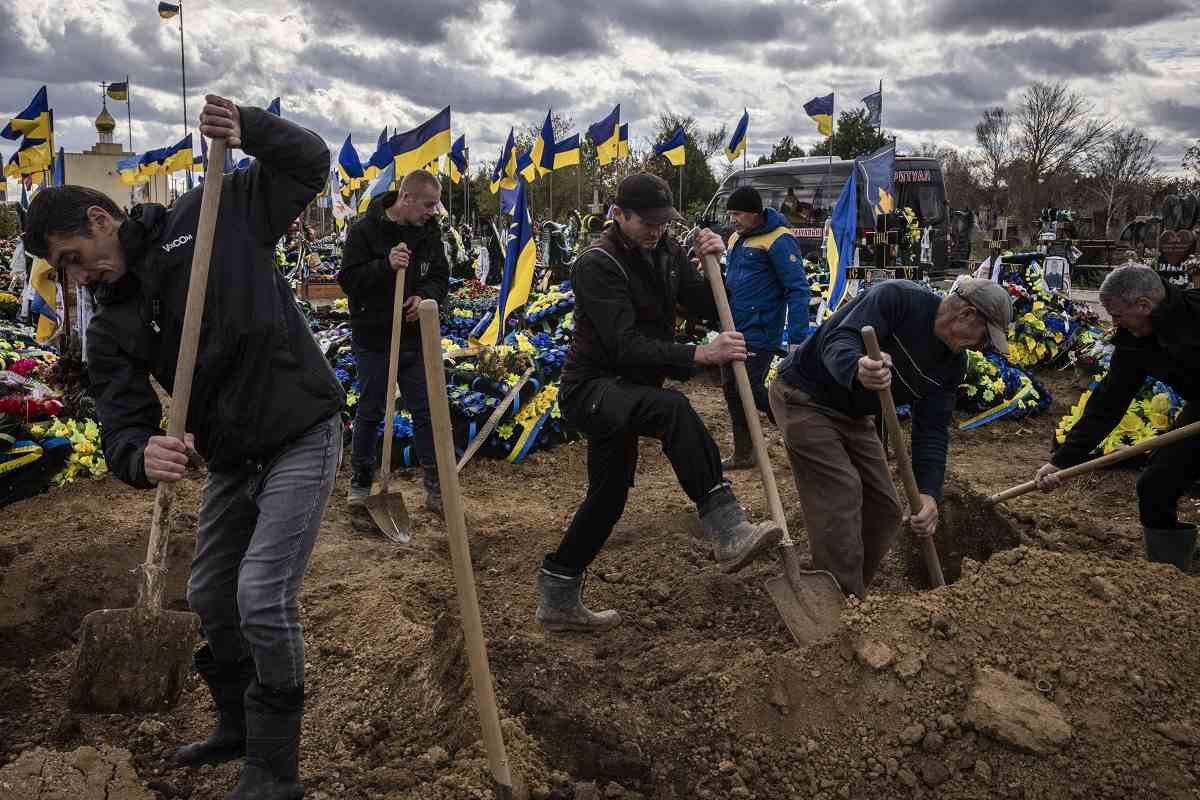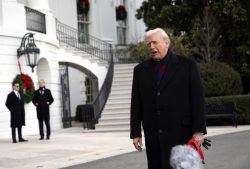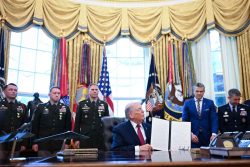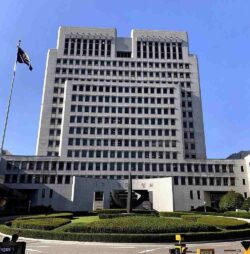
The graves of two Ukrainian soldiers, Dmytro Medvid, 33, and Oleksandr Ulanovskyy, 37, are covered during thier funeral on the outskirts of Kherson in mid-November.
13:17 JST, April 28, 2024
A long-awaited influx of U.S. weapons will help Ukraine to blunt Russia’s advance in the coming months, Biden administration officials said after Congress passed a major aid package, but an acute troop shortage and Moscow’s firepower advantage mean that Kyiv won’t likely regain major offensive momentum until 2025 at the earliest.
Lawmakers’ approval of the foreign aid bill following months of partisan gridlock was a victory for President Biden. The sprawling legislation includes $61 billion to fuel Ukraine’s fight against Russia’s invading forces.
As initial shipments of arms, including artillery shells, air defense missiles, and armored vehicles, begin to reach Ukraine, U.S. officials said they expect the new weapons will buy time for Kyiv to replenish its military ranks and strengthen battlefield defenses – including trenches and minefields – ahead of an expected Russian offensive.
A U.S. defense official, who like some others spoke on the condition of anonymity to discuss Western projections, said the aid would give Ukraine the chance to better cope with continued Russian attacks “whether on the front lines or in the skies” and more effectively defend troops and civilians alike.
“But time is precious,” the official said. “And time shouldn’t be wasted.”
The foreign aid package’s approval, over objections from a cohort of House Republicans, was a desperately needed injection of hope for Ukraine, where exhausted combat units have been outgunned 5 to 1 as they have been forced to ration ammunition in the face of Russian glide bombs and increasingly bold aircraft assaults. As the legislation languished in Congress, Ukrainian officials made urgent pleas for air defense systems, blaming the shortage for Russia’s string of successful attacks on cities and power plants.
President Volodymyr Zelensky characterized the long-delayed American aid as a lifeline, but stressed that the promised resupply must arrive quickly. “We will have a chance for victory if Ukraine really gets the weapon system which we need so much,” he told NBC News last weekend. Zelensky’s office did not immediately respond to a request seeking comment for this report, but has acknowledged the challenges Ukraine’s military faces.
More than two years after President Vladimir Putin’s full-scale invasion, Ukrainian forces have lost their early battlefield momentum and most U.S. officials interviewed for this report believe Zelensky faces no clear military course to regaining the 20 percent of his country that Russia now occupies. While Russia has lost more than 300,000 troops to injury or death, according to U.S. estimates, it retains advantages in manpower and hardware, as Moscow continues to outproduce the West in artillery and other arms while having turned to Iran and North Korea for help supplementing its domestic industrial capacity.
White House national security adviser Jake Sullivan said Wednesday that Ukraine would need time to “dig out of the hole” caused by Congress’s six-month delay.
Biden administration officials cite what they believe Ukraine has done well despite the disappointment of its unsuccessful counteroffensive last year: defending vulnerable areas in Ukraine’s north and east, where Kyiv has permitted only limited Russian gains in the past year; keeping crucial commercial shipping lanes open in the Black Sea while putting Russia’s naval fleet on the defensive; and threatening the Kremlin’s stronghold in the occupied Crimea peninsula.
They frame 2024 as primarily a defensive year for Ukraine, but also cite the promise of new capabilities the West is supplying, including long-range ATACMS missiles provided by the United States in recent weeks, that will allow Ukraine to strike more effectively into Crimea, an important Russian staging ground. Western nations are also expected to begin delivering a limited number of F-16 fighter jets later this year.
Defense Secretary Lloyd Austin on Friday announced the administration’s intent to contract $6 billion in arms for Ukraine, including Patriot air-defense missiles and counter-drone systems – a tranche of vitally needed arms, he said, but one that could take months if not years to produce. The administration has employed a two-tiered approach to helping Ukraine: one entails the immediate drawdown and transfer of existing U.S. military stockpiles; the other is aimed at long-term sustainment through purchase orders for weapons and ammunition.
Austin, speaking to reporters Friday, said Ukraine’s path would be “dependent upon whether or not Ukraine can effectively employ these systems and sustain those systems, and whether or not Ukraine can mobilize an adequate number of troops to replenish its ranks.”
Air Force Gen. Charles Q. Brown, chairman of the Joint Chiefs of Staff, said the newly approved funding package would “help shape the future.”
With the battle in Congress now over, U.S. officials say they will turn their focus to Ukraine’s other urgent challenges, including the country’s struggle to mobilize more troops.
In recent weeks, Ukrainian lawmakers have passed steps to streamline conscription and lower the age for men to be eligible to be drafted for military service from 27 to 25. Zelensky’s government, hoping to reclaim fighting power from a population far smaller than Russia’s, also has asked European nations to help encourage the return of some of the millions of military-age men who fled Ukraine following Putin’s invasion.
“The manpower situation is the growing problem,” said Rob Lee, a former U.S. Marine now at the Foreign Policy Research Institute who has closely followed the Ukraine conflict. “And if that’s not fixed, then this aid package is not going to solve all Ukraine’s issues.”
Kyiv has not said how many troops will be needed in 2024 and 2025. Ukraine’s previous top commander, whom Zelensky replaced in February, said that number could be as high as a half-million. While the current commander has said the number is smaller, even marshaling a fraction of that is a risky proposition for Zelensky.
Ukraine’s personnel shortfalls also underscore the political challenges that Zelenksy’s government will likely face as the war grinds on. The ongoing debate over mobilization is a delicate one for Zelensky, who must marshal enough combat power to keep Russia at bay but also avoid shattering the national unity already under strain after more than two years of bloodshed and deprivation.
A U.S. official said the Biden administration is cognizant of the delicacy of its conversations with counterparts in Kyiv about the country’s personnel gap.
“Who are we to say, ‘You just need to draft more men to fight.’ But at the same time, it is a real concern,” the official said. “The laws they have passed in the past couple of weeks will help them, but they’ve got to mobilize more forces and find a way to inspire more Ukrainian men to come to the front lines.”
A Ukrainian lawmaker who spoke on the condition of anonymity to be candid said they believed Zelensky’s announcement in February that 31,000 soldiers had been killed since 2022 vastly downplayed the war’s true toll.
The military death count, which Ukraine had long refused to disclose, likely had to be presented as lower to avoid disrupting an already-struggling recruitment and mobilization drive, the lawmaker said.
The lawmaker acknowledged that there is a manpower shortage, especially as Russia ramps up its recruitment – but that the situation has not reached a “red line.”
“I don’t think it’s an emergency right now,” the lawmaker said. “We do need more people, but we need to balance.”
The mobilization effort has been hampered in part by concerns over the open-ended timeline of a combat tour, frustrations with low pay and concerns that Ukraine’s government will not properly care for the families of those killed or wounded, the lawmaker said.
“We see so many deaths and so many wounded,” the lawmaker said. “If they go, [troops] want to know how long they will be there.”
Crucial to regaining momentum, Lee said, is for Ukraine to get more recruits in uniform soon, because they must be trained individually and in groups if Kyiv hopes to avoid the problems it encountered during last year’s failed offensive.
“All that requires time, and that’s why the longer it goes without fixing the manpower and mobilization situation, the less likely a large-scale 2025 offensive becomes,” Lee said.
The U.S. military’s training program for Ukrainian troops, an effort concentrated in Europe, has slowed, officials say, suggesting a depletion of the personnel pipeline. The last brigade trained in Germany was in January or February, the officials said.
Ukraine’s strongest European backers are equally troubled by its manpower situation. Poland, which like other countries from NATO’s eastern flank is investing heavily in its own defenses, is the primary transit point for the vast majority of U.S. aid flowing into Ukraine.
Maj. Gen. Krzysztof Nolbert, Poland’s defense attaché in Washington, said renewing Ukrainian forces and acquiring promised arms would likely lead to success “given the exhausted and poorly trained state” of Russian forces.
“It’s definitely the time to reconstitute the troops,” he said. “It is perhaps the most critical factor that will determine whether they will be successful or not.”
Although Russia has relied on poorly trained troops, it has in recent months ramped up weapons production and now significantly outguns Ukraine’s forces. Washington recently acknowledged that Russia’s forces are not as depleted as was once understood and that Russian troops have adapted on the battlefield.
U.S. officials also cite a need to build out Ukraine’s physical defenses ahead of Russia’s expected offensive. Ukrainian forces have spent the last year digging trenches, putting in place barriers and laying mines, but U.S. officials believe more must be done. They hope the antitank and anti-personnel mines included in the arms package announced in recent days will help.
They also hold out hope that Ukraine can find opportunities to reclaim smaller pockets of Russian-controlled areas in 2024, even if it can’t mount a major offensive.
“The good news is that Russia, years in this war, has not found a way to substantially take advantage of Ukrainian weaknesses,” the U.S. official said.
The Biden administration’s attempt to steer Ukraine toward a more sustainable course against Russia occurs as it prepares to host a major summit in July marking the NATO alliance’s 75th anniversary.
While the Biden administration has already ruled out issuing an invitation for Ukraine to join NATO during the summit, two of Ukraine’s leading advocates in Congress are urging the president to approach the event with the idea that “Ukraine should be offered a realistic path to NATO membership” once it has met the alliance’s conditions and requirements.
“We must send an unmistakable message to Putin that Ukraine’s future lies firmly with Europe,” Sens. Jeanne Shaheen (D-N.H.) and Thom Tillis (R-N.C.) wrote in a letter to Biden on Friday.
"News Services" POPULAR ARTICLE
-

American Playwright Jeremy O. Harris Arrested in Japan on Alleged Drug Smuggling
-

Taiwan President Shows Support for Japan in China Dispute with Sushi Lunch
-

Japan’s Nikkei Stock Average as JGB Yields, Yen Rise on Rate-Hike Bets
-

Japan’s Nikkei Stock Average Licks Wounds after Selloff Sparked by BOJ Hike Bets (UPDATE 1)
-

Japanese Bond Yields Zoom, Stocks Slide as Rate Hike Looms
JN ACCESS RANKING
-

Japan’s Hopes for Seafood Exports Shot Down in China Spat
-

Keidanren Chairman Yoshinobu Tsutsui Visits Kashiwazaki-Kariwa Nuclear Power Plant; Inspects New Emergency Safety System
-

Japan to Charge Foreigners More for Residence Permits, Looking to Align with Western Countries
-

Japan Exports Rise in October as Slump in U.S. Sales Eases
-

Govt Aims to Expand NISA Program Lineup, Abolish Age Restriction



























